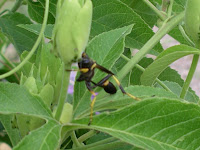 Since I covered a "creepy" bug last week, I decided to go with one that everyone generally likes to have around.
Since I covered a "creepy" bug last week, I decided to go with one that everyone generally likes to have around.Mantids are easily recognized by their elongated thorax and specialized, raptorial front legs that are use to capture prey. They also have large compound eyes and a neck that can swivel 180 degrees. Mantids are generalist predators that will capture and eat a wide variety of small prey. They really don't differentiate between "good" and "bad" bugs, so they are best to conserve when you see them in the garden, but augment the population as they are cannibalistic and will also often bee seen eating honey bees.
After mating, females lay eggs in a frot hy egg case on twigs, vines or other locations. The frothy egg case eventually hardens which will help protect the eggs throughout the winter. In the spring, small mantids (nymphs) will emerge from the egg case. It's actually rather interesting to watch as the first mantid out gets a meal delivered to them when the next nymph comes out of the egg case.
hy egg case on twigs, vines or other locations. The frothy egg case eventually hardens which will help protect the eggs throughout the winter. In the spring, small mantids (nymphs) will emerge from the egg case. It's actually rather interesting to watch as the first mantid out gets a meal delivered to them when the next nymph comes out of the egg case.
 hy egg case on twigs, vines or other locations. The frothy egg case eventually hardens which will help protect the eggs throughout the winter. In the spring, small mantids (nymphs) will emerge from the egg case. It's actually rather interesting to watch as the first mantid out gets a meal delivered to them when the next nymph comes out of the egg case.
hy egg case on twigs, vines or other locations. The frothy egg case eventually hardens which will help protect the eggs throughout the winter. In the spring, small mantids (nymphs) will emerge from the egg case. It's actually rather interesting to watch as the first mantid out gets a meal delivered to them when the next nymph comes out of the egg case.If you have kids who like bugs, or are interested yourself, you can either collect an egg case that you find or buy one from the store to watch the little guys and gals come out. If it's warm enough outside, you can release them into the backyard to have a go at it. If it's too cold outside for them to survive, you can keep them in a 10 gallon fish tank and feed them insects (pinhead crickets work great while they're small). Remember, they are cannibalistic, so don't forget to feed them!





